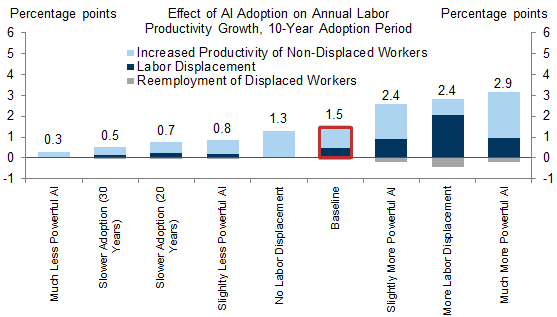Overview of Generative AI and Its Emerging Impact
Generative AI is rapidly transforming global economies by streamlining workflows, enhancing content creation, and reducing operational costs, while also presenting challenges around economic displacement and inclusivity[9][10]. In emerging markets, the absence of legacy infrastructure creates opportunities to adopt optimized AI-powered systems and data centers, enabling these economies to leapfrog existing technologies and accelerate productivity[1].
Economic Opportunities and Challenges in Emerging Markets
Emerging markets are uniquely positioned to take advantage of generative AI, as these regions can design modern data infrastructures without being hampered by outdated systems. For example, businesses can directly adopt state-of-the-art data center architectures, and generative AI is expected to revolutionize industries ranging from healthcare to communications in these regions[1]. Meanwhile, reports from leading financial institutions indicate that AI-driven innovations could raise global GDP significantly—up to 7% according to one analysis—and spur new business applications that foster economic growth[9][10].
At the same time, the rise of AI poses risks of job displacement across several sectors. Entry-level roles that have traditionally served as a training ground for new talent are increasingly vulnerable to automation by AI-powered tools, potentially reducing opportunities for emerging workforces. However, many experts believe that with strong upskilling programs and strategic investments in education, these challenges can be mitigated, allowing AI to coexist with human labor to create more advanced opportunities[5].
Bridging the Digital Divide and Enhancing Access
The digital divide encompasses gaps in availability, affordability, quality, and relevance of internet access. Nearly 3.6 billion people remain unconnected worldwide, highlighting the need for better community networks and supportive infrastructure to bridge this gap[7]. In low-income countries, limited technology access and a lack of digital skills further restrict the benefits of AI-driven solutions, creating what many experts refer to as a self-reinforcing cycle of inequality[3].
Policymakers and industry leaders must therefore work together to expand internet connectivity, invest in community-run networks, and implement training programs that improve digital literacy. This multifaceted approach is critical to ensuring that the benefits of generative AI are widely distributed and that vulnerable populations are not left behind.
Language Representation and Cultural Relevance

An equally significant aspect of digital inequality is the language barrier. Dominant global languages such as English, Chinese, and Spanish receive the bulk of investments and technological support, while low-resource languages—like Malagasy or Navajo—struggle with insufficient digital content and technological backing[2]. This linguistic digital divide means that billions of people, especially in emerging economies, do not benefit fully from digital advances if the content is not accessible in their native tongues[4].
Investing in local language technologies not only improves digital inclusivity but also transforms how communities interact with information. Studies have shown that vernacular digital content can significantly enhance engagement and credibility, thereby supporting local entrepreneurship, job creation, and cultural preservation.
From Economic Displacement to Workforce Transformation
The integration of generative AI into various sectors is accompanied by both opportunities and risks. On one hand, AI has the potential to enhance productivity and drive innovation; on the other hand, it may displace traditional job roles, particularly those at the entry level. For instance, repetitive tasks in fields such as market research and sales are increasingly being automated, which could adversely impact job opportunities for less experienced workers[5].
The challenge lies in transforming these disruptions into opportunities for growth. Investments in training and reskilling, along with strategic state and private sector initiatives, are essential in redirecting the workforce towards higher-value tasks. By integrating advanced AI tools while simultaneously prioritizing workforce development, companies can foster an environment where technological advances contribute to long-term job creation and economic diversification[10].
Inclusive Innovation Policies and Recommendations

To realize the full potential of generative AI while mitigating risks to digital equality in emerging markets, there is a clear need for inclusive innovation policies. These policies should focus on several key areas:
• Enhancing digital infrastructure and connectivity to bridge the access gap, particularly in underserved and rural areas[7].
• Investing in comprehensive digital literacy and skills training programs that empower local communities to adopt and benefit from advanced technologies[3].
• Promoting the development and deployment of language technologies that support low-resourced languages to ensure that all populations can access digital content in their native languages[2][4].
• Facilitating public-private collaborations that create diversified value chains and foster local ownership of AI technology, ensuring that emerging market companies can compete on an equal footing with large multinational firms[1].
• Implementing robust regulatory frameworks that protect vulnerable groups and ensure ethical use of automated systems, while at the same time encouraging the development of new business models that integrate AI innovations responsibly[5].
By addressing these areas, governments and stakeholders can ensure that generative AI acts as a force for inclusive development, balancing economic growth with the need for social equity and cultural preservation.
Get more accurate answers with Super Pandi, upload files, personalized discovery feed, save searches and contribute to the PandiPedia.
Let's look at alternatives:
- Modify the query.
- Start a new thread.
- Remove sources (if manually added).



